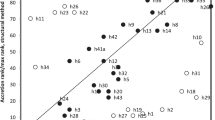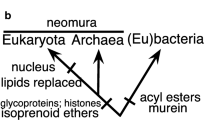Summary
A tree was constructed from a structurally conserved area in an alignment of 83 small ribosomal subunit sequences of eukaryotic, archaebacterial, eubacterial, plastidial, and mitochondrial origin. The algorithm involved computation and optimization of a dissimilarity matrix. According to the tree, only plant mitochondria belong to the eubacterial primary kingdom, whereas animal, fungal, algal, and ciliate mitochondria branch off from an internal node situated between the three primary kingdoms. This result is at variance with a parsimony tree of similar size published by Cedergren et al. (J Mol Evol 28∶98–112, 1988), which postulates the mitochondria to be monophyletic and to belong to the eubacterial primary kingdom. The discrepancy does not follow from the use of conflicting sequence alignments, hence it must be due to the use of different treeing algorithms. We tested our algorithm on a set of sequences resulting from a simulated evolution and found it capable of faith-fully reconstructing a branching topology that involved very unequal evolutionary rates. The use of more limited or more extended areas of the complete sequence alignment, comprising only very conserved or also more variable portions of the small ribosomal subunit structure, does have some influence on the tree topology. In all cases, however, the nonplant mitochondria seem to branch off before the emergence of eubacteria, and the differences are limited to the branching pattern among different types of mitochondria.
Similar content being viewed by others
Abbreviations
- srRNA:
-
small ribosomal subunit RNA
References
Achenbach-Richter L, Stetter KO, Woese CR (1987) A possible missing link among archaebacteria. Nature 327:348–349
Achenbach-Richter L, Gupta R, Zillig W, Woese CR (1988) Rooting the archaebacterial tree: the pivotal role ofThermococcus celer in archaebacterial evolution. Syst Appl Microbiol 10:231–240
Benne R, Sloof P (1987) Evolution of the mitochondrial protein synthetic machinery. BioSystems 21:51–68
Brosius J, Dull TJ, Sleeter DD, Noller HF (1981) Gene organization and primary structure of a ribosomal RNA operon fromEscherichia coli. J Mol Biol 148:107–127
Brown WM, Prager EM, Wang A, Wilson AC (1982) Mitochondrial DNA sequences of primates: tempo and mode of evolution. J Mol Evol 18:225–239
Cedergren R, Gray MW, Abel Y, Sankoff D (1988) The evolutionary relationships among known life forms. J Mol Evol 28:98–112
Clemmey H (1976) World's oldest animal traces. Nature 261:576–578
Dams E, Yamada T, De Baere R, Huysmans E, Vandenberghe A, De Wachter R (1987) Structure of 5S rRNA in actinomycetes and relatives and evolution of eubacteria. J Mol Evol 25:255–260
Dams E, Hendriks L, Van de Peer Y, Neefs J-M, Smits G, Vandenbempt I, De Wachter R (1988) Compilation of small ribosomal subunit RNA sequences. Nucleic Acids Res 16:r87-r173
de la Cruz VF, Lake JA, Simpson AM, Simpson L (1985) A minimal ribosomal RNA: sequence and secondary structure of the 9S kinetoplast ribosomal RNA fromLeishmania tarentolae. Proc Natl Acad Sci USA 82:1401–1405
de Soete G (1983) A least squares algorithm for fitting additive trees to proximity data. Psychometrika 48:621–626
Dickerson RE, Timkovich R, Almassy RJ (1976) The cytochrome fold and the evolution of bacterial energy metabolism. J Mol Biol 100:473–491
Dorsch M, Moreno E, Stackebrandt E (1989) Nucleotide sequence of the 16S rRNA fromBrucella abortus. Nucleic Acids Res 17:1765
Emberger L (1968) Les plantes fossiles dans leurs rapports avec les végétaux vivants. Masson et Cie, Paris
Field KG, Olsen GJ, Lane DJ, Giovannoni SJ, Ghiselin MT, Raff EC, Pace NR, Raff RA (1988) Molecular phylogeny of the animal kingdom. Science 239:748–753
Fox TD (1987) Natural variation in the genetic code. Annu Rev Genet 21:67–91
Giovannoni SJ, Turner S, Olsen GJ, Barns S, Lane DJ, Pace NR (1988) Evolutionary relationships among cyanobacteria and green chloroplasts. J Bacteriol 170:3584–3592
Gray MW (1982) Mitochondrial genome diversity and the evolution of mitochondrial DNA. Can J Biochem 60:157–171
Gray MW (1988) Organelle origins and ribosomal RNA. Biochem Cell Biol 66:325–348
Gray MW, Doolittle WF (1982) Has the endosymbiont hypothesis been proven? Microbiol Rev 46:1–42
Gray MW, Sankoff D, Cedergren RJ (1984) On the evolutionary events of organisms and organelles: a global phylogeny based on a highly conserved structural core in small subunit ribosomal RNA. Nucleic Acids Res 12:5837–5853
Gray MW, Cedergren R, Abel Y, Sankoff D (1989) On the evolutionary origin of the plant mitochondrion and its genome. Proc Natl Acad Sci USA 86:2267–2271
Hendriks L, Van Broeckhoven C, Vandenberghe A, Van de Peer Y, De Wachter R (1988) Primary and secondary structure of the 18S ribosomal RNA of the bird spider.Eurypelma californica and evolutionary relationships among eukaryotic phyla. Eur J Biochem 177:15–20
Hori H, Osawa S (1987) Origin and evolution of organisms as deduced from 5S ribosomal RNA sequences. Mol Biol Evol 4:445–472
Hunt LT, George DG, Barker WC (1985) The prokaryote-eukaryote interface. BioSystems 18:223–240
Huysmans E, De Wachter R (1986) The distribution of 5S ribosomal RNA sequences in phenetic hyperspace. Implications for eubacterial, eukaryotic, archaebacterial and early biotic evolution. Endocyt C Res 3:133–155
John P, Whatley FR (1975)Paracoccus denitrificans and the evolutionary origin of the mitochondrion. Nature 254:495–498
Jukes TH, Cantor CR (1969) Evolution of protein molecules. In: Munro HN (ed) Mammalian protein metabolism, vol III. Academic Press, New York, pp 21–132
Kimura M (1980) A simple method for estimating evolutionary rates of base substitutions through comparative studies of nucleotide sequences. J Mol Evol 16:111–120
Kimura M, Ohta T (1972) On the stochastic model for estimation of mutational distance between homologous proteins. J Mol Evol 2:87–90
Küntzel H, Köchel HG (1981) Evolution of rRNA and origin of mitochondria. Nature 293:751–755
Lake JA (1987) Prokaryotes and archaebacteria are not monophyletic: rate invariant analysis of rRNA gene indicates that eukaryotes and eocytes form a monophyletic taxon. Cold Spring Harbor Symp Quant Biol 52:839–846
Lake JA (1988) Origin of the eukaryotic nucleus determined by rate-invariant analysis of rRNA sequences. Nature 331:184–186
McCarroll R, Olsen GJ, Stahl YD, Woese CR, Sogin ML (1983) Nucleotide sequence of theDictyostelium discoideum small-subunit ribosomal ribonucleic acid inferred from the gene sequence: evolutionary implications. Biochemistry 22:5858–5868
Mikelsaar R (1987) A view of early cellular evolution. J Mol Evol 25:168–183
Nagae Y, Fujii H, Yoneyama Y, Goto Y, Okazaki T (1988) Nucleotide sequence of theRana catesbeiana mitochondrial small (12S) and large (16S) ribosomal RNA genes. Nucleic Acids Res 16:10363
Press WH, Flannery DP, Teukolsky SA, Vetterling WT (1985) Numerical recipes: the art of scientific computing. Cambridge University Press, Cambridge, MA
Ree HK, Cao K, Thurlow DL, Zimmerman RA (1989) The structure and organization of the 16S ribosomal RNA gene from the archaebacteriumThermoplasma acidophylum. Can J Microbiol 35:124–133
Rensch B (1972) Neuere Probleme der Abstammungslehre. Ferdinand Enke Verlag, Stuttgart
Sarich VM, Wilson AC (1967) Immunological time scale for hominid evolution. Science 158:1200–1202
Schwartz RM, Dayhoff MO (1978) Origins of prokaryotes, eukaryotes, mitochondria, and chloroplasts. Science 199:395–403
Sloof P, Van den Burg J, Voogd A, Benne R, Agostinelli M, Borst P, Gutell R, Noller H (1985) Further characterisation of the extremely small mitochondrial ribosomal RNAs from trypanosomes: a detailed comparison of the 9S and 12S RNAs fromCrithidia fasciculata andTrypanosoma brucei with rRNA from other organisms. Nucleic Acids Res 13:4171–4190
Stackebrandt E, Murray RGE, Trüper HG (1988) Proteobacteria classis nov., a name for the phylogenetic taxon that includes the “purple bacteria and their relatives”. Int J Syst Bacteriol 38:321–325
Van den Eynde H, De Baere R, De Roeck E, Van de Peer Y, Vandenberghe A, Willekens P, De Wachter R (1988) The 5S ribosomal RNA sequences of a red algal rhodoplast and a gymnosperm chloroplast. Implications for the evolution of plastids and cyanobacteria. J Mol Evol 27:126–132
Woese CR (1987) Bacterial evolution. Microbiol Rev 51:221–271
Woese CR, Fox E (1977) Phylogenetic structure of the prokaryotic domain: the primary kingdoms. Proc Natl Acad Sci USA 74:5088–5090
Woese CR, Olsen GJ (1986) Archaebacterial phylogeny: perspectives on the urkingdoms. Syst Appl Microbiol 7:161–177
Wolters J, Erdmann VA (1989) The structure and evolution of archaebacterial ribosomal RNAs. Can J Microbiol 35:43–51
Yang D, Oyaizu Y, Oyaizu H, Olsen GJ, Woese CR (1985) Mitochondrial origins. Proc Natl Acad Sci USA 82:4443–4447
Author information
Authors and Affiliations
Rights and permissions
About this article
Cite this article
Van de Peer, Y., Neefs, JM. & De Wachter, R. Small ribosomal subunit RNA sequences, evolutionary relationships among different life forms, and mitochondrial origins. J Mol Evol 30, 463–476 (1990). https://doi.org/10.1007/BF02101118
Received:
Revised:
Issue Date:
DOI: https://doi.org/10.1007/BF02101118




